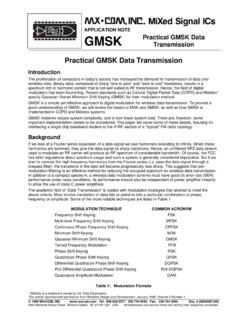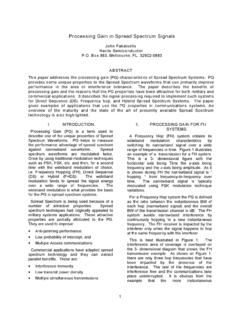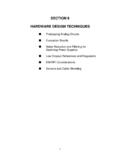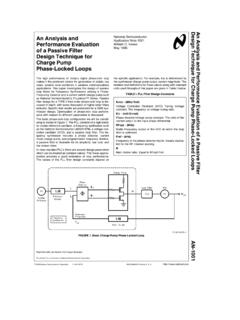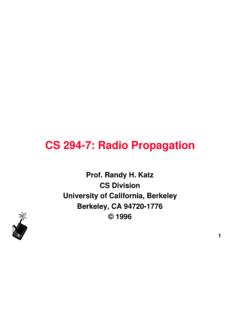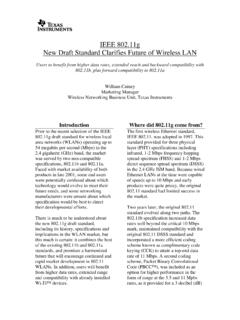Transcription of CS 294-7: Digital Modulation - Spread spectrum
1 1CS 294-7: Digital ModulationProf. Randy H. KatzCS DivisionUniversity of California, BerkeleyBerkeley, CA 94720-1776 19962 Analog Modulation : AM RadioSpeechSignalTimeTimeAmplitudeTimeRe plica ofSpeech SignalCarrier amplitude wherespeech signal is zeroCarrier frequencyAmplitude Modulation (AM)3 Analog Modulation : FM RadioSpeechSignalTimeTimeAmplitudeCarrie r AmplitudeFrequency Modulation (FM)HighestFrequencyLowestFrequencySigna l goesnegativeNoise has a greater effecton amplitude than frequencySufficient to detect zerocrossings to reconstructthe signalEasy to eliminate amplitudedistortionConstant envelope, , envelopeof carrier wave does not changewith changes in modulated signalThis means that more efficientamplifiers can be used, reducingpower demands4 Detection of FM SignalReceivedSignalLimiterDifferentiato rRectifierPulseGeneratorLow PassFilterSlicerThresholdsSlicerNoise translates intoamplitude changes, andsometimes frequencychangesDetection based onzero crossings.
2 ThelimiterAlternative schemesto translate limited signalinto bit streams5 Digital Modulation Techniques Carrier wave s: s(t) = A(t) * cos[(t)] Function of time varying amplitude A and time varying angle Angle rewritten as: (t) = 0 + (t) 0 radian frequency, phase (t) s(t) = A(t) cos[0t + (t)] radians per second relationship between radians per second and hertz 6 Digital Modulation Techniques Demodulation Process of removing the carrier signal Detection Process of symbol decision Coherent detection Receiver users the carrier phase to detect signal Cross correlate with replica signals at receiver Match within threshold to make decision Noncoherent detection Does not exploit phase reference information Less complex receiver, but worse performance7 Digital Modulation TechniquesCoherentPhase shift keying (PSK)Frequency shift keying (FSK)Amplitude shift keying (ASK)Continuous phase Modulation (CPM)HybridsNoncoherentFSKASKD ifferential PSK (DPSK)CPMH ybridsCoherent (aka synchronous) detection: process received signal witha local carrier of same frequency and phaseNoncoherent (aka envelope) detection.
3 Requires no reference wave8 Metrics for Digital Modulation Power Efficiency Ability of a Modulation technique to preserve the fidelity of the Digital message at low power levels Designer can increase noise immunity by increasing signal power Power efficiency is a measure of how much signal power should be increased to achieve a particular BER for a given Modulation scheme Signal energy per bit / noise power spectral density: Eb / N0 Bandwidth Efficiency Ability to accomodate data within a limited bandwidth Tradeoff between data rate and pulse width Thruput data rate per hertz: R/B bps per Hz Shannon Limit: Channel capacity / bandwidth C/B = log2(1 + S/N)9 Digital Modulation Techniques Modify carrier s amplitude and/or phase (and frequency) Constellation: Vector notation/polar coordinatesI = M cos Q = M sin MM = magnitude = phaseIn-phase componentQuadrature component (carrier shifted 90 )Densely packedimplies bandwidthefficientBit error prob relatedto distances betweenclosest points10 Considerations in Choice of Modulation Scheme High spectral efficiency High power efficiency Robust to multipath effects Low cost and ease of implementation Low carrier-to-cochannel interference ratio Low out-of-band radiation Constant or near constant envelope Constant: only phase is modulated Non-constant.
4 Phase and amplitude modulated11 Binary Modulation Schemes Amplitude Shift Keying (ASK) Transmission on/off to represent 1/0 Note use of term keying, like a telegraph key Frequency Shift Keying (FSK) 1/0 represented by two different frequencies slightly offset from carrier frequencyDataHigh FrequencyLow FrequencyFSK Waveform12 Phase Shift Keying Binary Phase Shift Keying (BPSK) Use alternative sine wave phase to encode bits Simple to implement, inefficient use of bandwidth Very robust, used extensively in satellite communicationsIQ1 state0 statePhases separated by 180 ( radians)DataCarrierCarrier + BPSKW aveform13 Phase Shift Keying Quadrature Phase Shift Keying (QPSK) Multilevel Modulation technique: 2 bits per symbol More spectrally efficient, more complex receiverIQ11 state01 state10 state00 statePhase of carrier: /4, 3 /4, 5 /4, 7 /42x bandwidth efficiency of BPSKO utput waveform is sum of modulated Cosine and Sine wave14 Quadrature Phase Shift KeyingCosine Carrier WaveCos + Sin1 1 4-Cos + Sin3 41 0-Cos - Sin5 40 0 Cos - Sin0 17 415 Minimum Shift Keying Special form of (continuous phase) frequency shift keying Minimum spacing that allows two frequencies states to be orthogonal Spectrally efficient, easily generatedIQTimeAmplitudeMinimum Shift Keying (MSK)1 cycle1 cyclesPhase continuity at the bit transitions16 Generating Minimum Shift KeyingDataOdd BitsEven BitsHigh FrequencyLow FrequencyMSK WaveformOdd, Even Bitsstretched to 2 bit timesOdd1-11-1 Even11-1-1 FreqHiLoLoHiSense+ + Bit ValueMSK OutputHi+Lo Lo Lo Lo Hi+Lo Hi Hi Notice smooth phase transitions!
5 17 Gaussian Minimum Shift Keying ( gmsk ) MSK + premodulation Gaussian low pass filter Increases spectral efficiency with sharper cutoff, excellent power efficiency due to constant envelope Used extensively in second generation Digital cellular and cordless telephone applications GSM Digital cellular: bps/Hz DECT cordless telephone: bps/Hz RAM Mobile DataMSK WaveformGMSK Waveform+90 -90 No sudden shifts in phase18 /4-Shifted QPSK Variation on QPSK Restricted carrier phase transition to +/- /4 and +/- 3 /4 Signaling elements selected in turn from two QPSK constellations, each shifted by /4 Maximum phase change is 135 vs. 180 for QPSK, thus maintaining constant envelope ( , amplitude of QPSK signal not constant for short interval during 180 phase changes) Popular in Second Generation Systems North American Digital Cellular (IS-54): bps/Hz Japanese Digital Cellular System: bps/Hz European TETRA System: bps/Hz Japanese Personal Handy Phone (PHP)IQ19 /4-Shifted QPSK Advantages: Two bits per symbol, twice as efficient as gmsk Phase transitions avoid center of diagram, remove some design constraints on amplifier Always a phase change between symbols, leading to self 00 00 01.
6 00011110 Data00011011 Phase Change45 135 -45 -135 20 Quadrature Amplitude Modulation Quadrature Amplitude Modulation (QAM) Amplitude Modulation on both quadrature carriers 2n discrete levels, n = 2 same as QPSK Extensive use in Digital microwave radio linksIQ16 Level QAM
